Combining theoretical reflections with materials from European case studies, the authors offer intriguing new methods for the sociological study of theatre.
Autorentext
Joshua Edelman worked as a research fellow at the Royal Central School of Speech & Drama, University of London. Louise Ejgod Hansen holds a research position at the theatre section of Aarhus University.Quirijn Lennert van den Hoogen is university lecturer of arts sociology and arts policy at the University of Groningen.
Inhalt
IntroductionCh. 1: How can we define autonomy? 1.1. The formula 1.2. The development and nature of specific capital 1.3. Actions of agents in theatre fields: Position-taking 1.4. Agents in theatre fields 1.5. Is theatre different? 1.6. Conclusion Ch. 2: The concept of artistic autonomy 2.1. The functional perspective on art 2.2. Dickie, Danto, and Becker: Art as an institution 2.3. Actor-Network Theory's critique of field theory 2.4. Boltanski and Thévenot: Art and value regimes 2.5. Conclusion Ch. 3: Autonomy in the contemporary theatre 3.1. Two forms of the argument against theatrical autonomy 3.2. Postdramatic and immersive theatre 3.3. Verbatim and documentary theatre 3.4. Applied and community theatre 3.5. Commercial theatre and stand-up comedy 3.6. Conclusion Ch. 4: How agents in theatre fields make use of claims to autonomy 4.1. How claims to autonomy influence the shape of the theatre field 4.2. Things that autonomy allows agents to do 4.3. Conclusion Ch. 5: How theatre organization shapes claims to autonomy 5.1. Funding systems 5.2. Training 5.3. The relation between production and distribution 5.4. Internationalization 5.5. The relation between national and regional subsidy 5.6. Conclusion Ch. 6: How claims to autonomy serve those outside theatre fields 6.1. Moral betterment and education 6.2. Issues of self-representation 6.3. Economic development 6.4. Social inclusion 6.5. Conclusion Conclusion References
